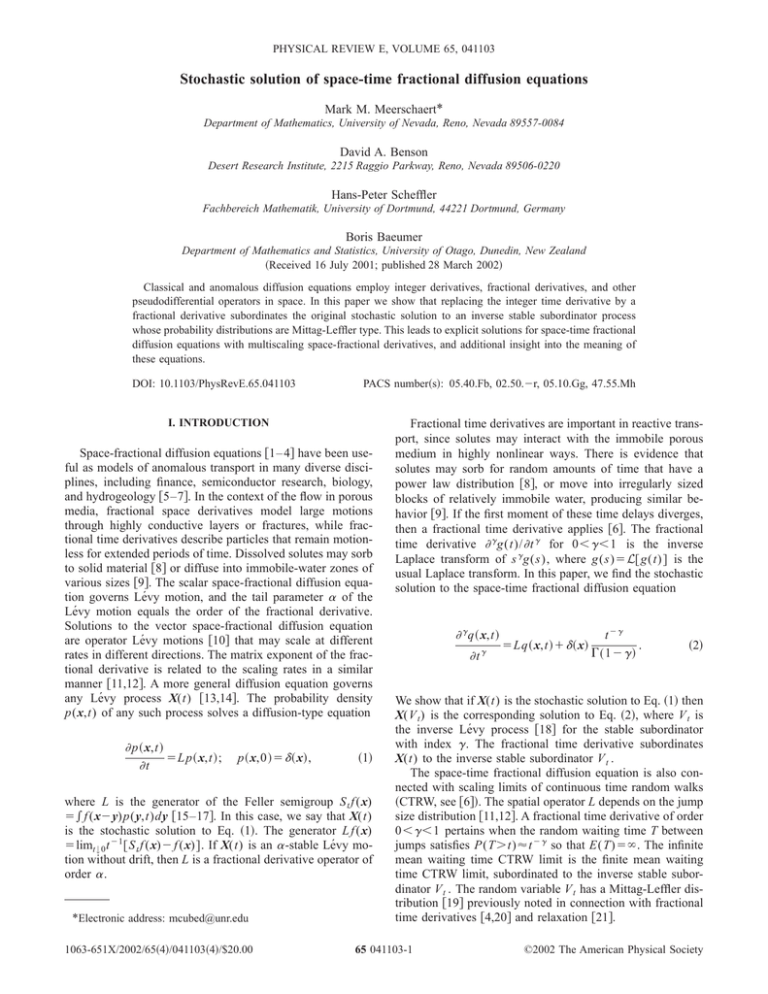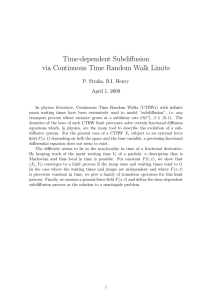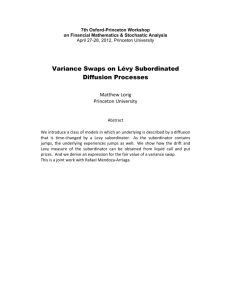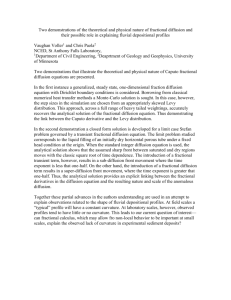Stochastic solution of space-time fractional diffusion equations * Mark M. Meerschaert
advertisement

PHYSICAL REVIEW E, VOLUME 65, 041103 Stochastic solution of space-time fractional diffusion equations Mark M. Meerschaert* Department of Mathematics, University of Nevada, Reno, Nevada 89557-0084 David A. Benson Desert Research Institute, 2215 Raggio Parkway, Reno, Nevada 89506-0220 Hans-Peter Scheffler Fachbereich Mathematik, University of Dortmund, 44221 Dortmund, Germany Boris Baeumer Department of Mathematics and Statistics, University of Otago, Dunedin, New Zealand 共Received 16 July 2001; published 28 March 2002兲 Classical and anomalous diffusion equations employ integer derivatives, fractional derivatives, and other pseudodifferential operators in space. In this paper we show that replacing the integer time derivative by a fractional derivative subordinates the original stochastic solution to an inverse stable subordinator process whose probability distributions are Mittag-Leffler type. This leads to explicit solutions for space-time fractional diffusion equations with multiscaling space-fractional derivatives, and additional insight into the meaning of these equations. DOI: 10.1103/PhysRevE.65.041103 PACS number共s兲: 05.40.Fb, 02.50.⫺r, 05.10.Gg, 47.55.Mh I. INTRODUCTION Space-fractional diffusion equations 关1– 4兴 have been useful as models of anomalous transport in many diverse disciplines, including finance, semiconductor research, biology, and hydrogeology 关5–7兴. In the context of the flow in porous media, fractional space derivatives model large motions through highly conductive layers or fractures, while fractional time derivatives describe particles that remain motionless for extended periods of time. Dissolved solutes may sorb to solid material 关8兴 or diffuse into immobile-water zones of various sizes 关9兴. The scalar space-fractional diffusion equation governs Lévy motion, and the tail parameter ␣ of the Lévy motion equals the order of the fractional derivative. Solutions to the vector space-fractional diffusion equation are operator Lévy motions 关10兴 that may scale at different rates in different directions. The matrix exponent of the fractional derivative is related to the scaling rates in a similar manner 关11,12兴. A more general diffusion equation governs any Lévy process X(t) 关13,14兴. The probability density p(x,t) of any such process solves a diffusion-type equation p 共 x,t 兲 ⫽L p 共 x,t 兲 ; t p 共 x,0 兲 ⫽ ␦ 共 x兲 , 共1兲 where L is the generator of the Feller semigroup S t f (x) ⫽ 兰 f (x⫺y)p(y,t)dy 关15–17兴. In this case, we say that X(t) is the stochastic solution to Eq. 共1兲. The generator L f (x) ⫽limt↓0 t ⫺1 关 S t f (x)⫺ f (x) 兴 . If X(t) is an ␣ -stable Lévy motion without drift, then L is a fractional derivative operator of order ␣ . *Electronic address: mcubed@unr.edu 1063-651X/2002/65共4兲/041103共4兲/$20.00 Fractional time derivatives are important in reactive transport, since solutes may interact with the immobile porous medium in highly nonlinear ways. There is evidence that solutes may sorb for random amounts of time that have a power law distribution 关8兴, or move into irregularly sized blocks of relatively immobile water, producing similar behavior 关9兴. If the first moment of these time delays diverges, then a fractional time derivative applies 关6兴. The fractional time derivative ␥ g(t)/ t ␥ for 0⬍ ␥ ⬍1 is the inverse Laplace transform of s ␥ g(s), where g(s)⫽L关 g(t) 兴 is the usual Laplace transform. In this paper, we find the stochastic solution to the space-time fractional diffusion equation ␥ q 共 x,t 兲 t␥ ⫽Lq 共 x,t 兲 ⫹ ␦ 共 x兲 t ⫺␥ . ⌫ 共 1⫺ ␥ 兲 共2兲 We show that if X(t) is the stochastic solution to Eq. 共1兲 then X(V t ) is the corresponding solution to Eq. 共2兲, where V t is the inverse Lévy process 关18兴 for the stable subordinator with index ␥ . The fractional time derivative subordinates X(t) to the inverse stable subordinator V t . The space-time fractional diffusion equation is also connected with scaling limits of continuous time random walks 共CTRW, see 关6兴兲. The spatial operator L depends on the jump size distribution 关11,12兴. A fractional time derivative of order 0⬍ ␥ ⬍1 pertains when the random waiting time T between jumps satisfies P(T⬎t)⬇t ⫺ ␥ so that E(T)⫽⬁. The infinite mean waiting time CTRW limit is the finite mean waiting time CTRW limit, subordinated to the inverse stable subordinator V t . The random variable V t has a Mittag-Leffler distribution 关19兴 previously noted in connection with fractional time derivatives 关4,20兴 and relaxation 关21兴. 65 041103-1 ©2002 The American Physical Society MEERSCHAERT, BENSON, SCHEFFLER, AND BAEUMER PHYSICAL REVIEW E 65 041103 c ⫺ ␥ N [ct] ⇒V t II. CTRW SCALING LIMITS CTRW were introduced 关22,23兴 to study random walks on a lattice. They are now used in physics to model a wide variety of phenomena connected with anomalous diffusion 关23–25兴. With finite mean waiting times, the jump process is asymptotically linear, and the CTRW behaves in a manner similar to the original random walk for large time 关20,26兴. For a scalar process, finite variance jumps lead to Brownian motion in the scaling limit. Infinite variance jumps with power law tails lead to Lévy motion. Vector jumps with finite second moments lead to multivariable Brownian motion. Vector jumps with power law tails lead to multivariable Lévy motion, or operator Lévy motion if the power law behavior varies with the direction of motion 关11,12兴. The speed of convergence to the CTRW scaling limit, and the implications for fractional diffusion modeling, are discussed in a recent paper of Barkai 关27兴. Many physical applications involve infinite mean waiting times 关21,28兴. Introducing infinite mean waiting times has the effect of subordinating the CTRW scaling limit to the inverse process of a stable subordinator whose index ␥ is the same as the power law tail index of the waiting times. Essentially, this is because the counting process for particle jumps is inverse to the jump time process. The jump time process is asymptotically the stable subordinator, so the counting process for particle jumps is asymptotically the inverse stable subordinator. A rigorous mathematical proof appears in 关29兴. We recount the basic ideas here to emphasize the physical applications. Given iid positive random variables J i let T n n ⫽ 兺 i⫽1 J i denote the time of the nth particle jump. The pon sition of the particle after the nth jump is W(n)⫽ 兺 i⫽1 Yi where Yi are iid and assumed independent of J i . Then N t ⫽max兵n:Tn⭐t其 counts the number of particle jumps by time t⬎0 and the CTRW variable W(N t ) gives the position of the particle at time t⬎0. If Y has zero mean and finite second moments, the simple random walk of particle jumps c ⫺1/2W共关 ct 兴 兲 ⇒X共 t 兲 as c→⬁, 共3兲 where the scaling limit X(t) is a Brownian motion. Shrinking the spatial coordinates by c 1/2 compensates expanding the time scale by c according to the central limit theorem. If P(J⬎t)⬇t ⫺ ␥ for some 0⬍ ␥ ⬍1 then c ⫺1/␥ T [ct] ⇒B t as c→⬁ 共4兲 according to the extended central limit theorem 关15兴 where the scaling limit B t is the stable subordinator process 关13兴. The ␥ -stable random variable B t is totally positively skewed, hence this Lévy process is strictly increasing. The inverse process V ⫽inf兵 t:B t ⬎ 其 is also called the hitting time or first passage time process. Using the fact that T n ,N t are inverse, so that 兵 N t ⭓x 其 ⫽ 兵 T dxe ⭐t 其 , along with Eq. 共4兲 yields as c→⬁. Hence N [ct] ⬇c ␥ V t , and together with Eq. 共3兲 this yields c ⫺ ␥ /2W共 N [ct] 兲 ⬇ 共 c ␥ 兲 ⫺1/2W共关 c ␥ V t 兴 兲 ⇒X共 V t 兲 as c→⬁, so that the Brownian motion X(t) is subordinated to the inverse stable subordinator V t . The inverse processes have inverse distributional scaling B ct ⫽c 1/␥ B t and V ct ⫽c ␥ V t , and together with the classical scaling for Brownian motion X(ct)⫽c 1/2X(t) this shows that the CTRW limit is subdiffusive X共 V ct 兲 ⫽X共 c ␥ V t 兲 ⫽c ␥ /2X共 V t 兲 with Hurst index H⫽ ␥ /2⬍1/2. Since P(V ⭐t)⫽ P(B t ⭓ ) ⫽ P(t 1/␥ B 1 ⭓ )⫽ P„(B 1 / ) ⫺ ␥ ⭐t… the random variable V has the same density function as ( /B 1 ) ␥ . The density g ␥ of the stable random variable B 1 has Laplace transform ␥ L关 g ␥ (t) 兴 ⫽e ⫺s . Computing moments of (t/B 1 ) ␥ shows that V t has a Mittag-Leffler distribution 关19兴. If p(x,t) is the density of X(t) then a conditioning argument along with a simple change of variable shows that X(V t ) has density q 共 x,t 兲 ⫽ 冕 ⫽ t ␥ ⬁ 0 p„x, 共 t/s 兲 ␥ …g ␥ 共 s 兲 ds 冕 ⬁ 0 p 共 x,u 兲 g ␥ 共 tu ⫺1/␥ 兲 u ⫺1/␥ ⫺1 du. 共5兲 Analytical estimates in 关29兴 show that q(k,t)⭓C 储 k储 ⫺b for large 储 k储 , so X(V t ) does not have a normal density and hence cannot be a fractional Brownian motion 关30兴. If P( 储 Y储 ⬎r)⬇r ⫺ ␣ for some 0⬍ ␣ ⬍2 then X(t) is an ␣ -stable Lévy motion and the CTRW limit X(V t ) has Hurst index H⫽ ␥ / ␣ . If the tail index varies with the spatial coordinate, operator norming applies 关12兴. Then X(ct)⫽c E X(t) leads to X(V ct )⫽c ␥ E X(t) so that the Hurst index H⫽ ␥ E is a matrix. For a diagonal exponent E⫽diag(1/␣ 1 , . . . ,1/␣ d ) the ith coordinate X i (t) is an ␣ i -stable Lévy motion and X i (V t ) is self-similar with Hurst index ␥ / ␣ i . Diagonalizable matrix exponents introduce a change of coordinates. Repeated eigenvalues thicken probability tails by a logarithmic factor, and complex exponents introduce rotations, leading to discrete scale invariance 关31兴. In every case, the scaling limit X(t) of the simple random walk is subordinated by the inverse stable subordinator V t and the density changes from p(x,t) to q(x,t) via Eq. 共5兲 when infinite mean waiting times are introduced. Next, we show that this change corresponds to a fractional time derivative in the diffusion equation. III. TIME-FRACTIONAL DIFFUSION EQUATIONS Wyss 关32兴 and Schneider and Wyss 关33兴 studied a timefractional diffusion equation. Zaslavsky 关34兴 introduced the space-time fractional kinetic equation 共2兲 for Hamiltonian chaos. When L⫽⫺ v / x⫹D ␣ / 兩 x 兩 ␣ Saichev and Zaslavsky 关35兴 show that if p(x,t) solves Eq. 共1兲 then the function q(x,t) given by Eq. 共5兲 solves Eq. 共2兲. When ␣ ⫽2 they call the stochastic solution to Eq. 共2兲 a ‘‘fractal 041103-2 STOCHASTIC SOLUTION OF SPACE-TIME . . . PHYSICAL REVIEW E 65 041103 Brownian motion.’’ We prefer the term ‘‘time-fractional diffusion’’ to avoid confusing this process with the well-known fractional Brownian motion. In fact, if X(t) is a Brownian motion, the stochastic solution to Eq. 共1兲 in this case, then the stochastic solution to Eq. 共2兲 is X(V t ) where V t is the inverse ␥ -stable subordinator. This interesting stochastic process is self-similar with Hurst index ␥ /2 so it is subdiffusive. However X(V t ) does not have a Gaussian distribution and it does not have stationary increments 关29兴, so it is not fractional Brownian motion. Barkai, Metzler, and Klafter 关20兴 introduce a fractional Fokker-Planck equation equivalent to Eq. 共2兲 with V ⬘共 x 兲 ⫹K 1 2 . x m1 x tional Cauchy problem 共2兲 via the inverse Lévy transform 共5兲. We summarize the essentials here in order to clarify the argument. Use s ␥ ⫺1 ⫽L关 t ⫺ ␥ /⌫(1⫺ ␥ ) 兴 and take Laplace-Fourier transforms (x哫k,t哫s) in Eq. 共2兲 to get s ␥ q(k,s) ⫽ (k)q(k,s)⫹s ␥ ⫺1 , where (k) is the Fourier symbol of L, so that F 关 L f (x) 兴 ⫽ (k) f (k). Then q 共 k,s 兲 ⫽ ⫽ 2 L⫽⫺ Barkai 关4兴 applies Eq. 共5兲, which he calls the inverse Lévy transform of p(x,t), to the solution of Eq. 共1兲 in order to solve this fractional Fokker-Planck equation. Scalar solutions to Eq. 共1兲 with L⫽⫺ v 冉 ␣ ␣ 1⫺  1⫹  ⫹D ⫹ ␣ x 2 共 ⫺x 兲 2 x␣ s ␥ ⫺1 s ␥ ⫺ 共 k兲 冕 ⬁ 0 are multivariable stable densities 关11兴, where erator with Fourier symbol 冕 储 储 ⫽1 ␥ exp兵 ⫺ 关 s ␥ ⫺ 共 k兲兴 u 其 du 共6兲 冕 ⬁ 0 1/␥ ) ␥ ⫽ 冕 ⬁ e ⫺su 1/␥ v 0 g ␥共 v 兲 d v e ⫺st g ␥ 共 u ⫺1/␥ t 兲 u ⫺1/␥ dt. 共7兲 Then compute ␥ s ␥ ⫺1 e ⫺s u ⫽ ⫽ is the op- ⫺1 d ␥ u ds 1 ␥u 冕 ⬁ 0 冉冕 ⬁ 0 e ⫺st g ␥ 共 u ⫺1/␥ t 兲 u ⫺1/␥ dt 冊 te ⫺st g ␥ 共 u ⫺1/␥ t 兲 u ⫺1/␥ dt 共8兲 and combine with Eq. 共6兲 to write q(k,s) as 冕 冉␥ 冕 冕 冉冕 ⬁ 共 ik• 兲 ␣ m 共 兲 d . 0 ⫽ 1 u ⬁ ⬁ 0 e ⫺st 0 q 共 k,t 兲 ⫽ where the generalized fractional derivative 冊 te ⫺st g ␥ 共 u ⫺1/␥ t 兲 u ⫺1/␥ dt p 共 k,u 兲 du ⬁ 0 冊 t p 共 k,u 兲 g ␥ 共 u ⫺1/␥ t 兲 u ⫺1/␥ ⫺1 du dt. ␥ Now invert the Laplace transform to obtain L⫽⫺ v •“⫹ 12 “•A“⫹F, 冕 0 ␥ ⫽ If ␣ ⫽2, this integral reduces to (ik)A(ik) ⬘ where the matrix A has i j component 兰 i j m( )d , and solutions are vector Brownian motion. Operator stable densities, where the stable index depends on the coordinate, solve Eq. 共1兲 with Ff 共 x 兲 ⫽ ⬁ s ␥ ⫺1 e ⫺s u p 共 k,u 兲 du, e ⫺s u ⫽e ⫺(su ␣ L⫽⫺ v •“⫹D“ m ␣ “m 冕 using 兰 ⬁0 e ⫺au du⫽a ⫺1 and p(k,t)⫽e (k)t , which follows ␥ ␥ from Eq. 共1兲. Use d(e ⫺s u )/ds⫽⫺ ␥ s ␥ ⫺1 ue ⫺s u to get ␥ ␥ ␥ s ␥ ⫺1 e ⫺s u ⫽⫺( ␥ u) ⫺1 d(e ⫺s u )/ds. Recall that e ⫺s ⫽L关 g ␥ (t) 兴 and write 冊 are ␣ -stable densities 关36,37兴, purely symmetric when the skewness  ⫽0 关2,38兴 and maximally skewed when  ⫽1 关3,34兴. When ␣ ⫽2 the skewness  is irrelevant, and the solutions are normal densities. Vector solutions for ⫽s ␥ ⫺1 t ␥ 冕 ⬁ 0 p 共 k,u 兲 g ␥ 共 tu ⫺1/␥ 兲 u ⫺1/␥ ⫺1 du and invert the Fourier transform to get Eq. 共5兲. 关 f 共 x⫺y 兲 ⫺ f 共 x 兲 ⫹y“ f 共 x 兲兴 d 共 y 兲 IV. CONCLUSIONS and d (r E )⫽r ⫺2 dr m( )d is an operator stable Lévy measure 关10,12,39兴. These are all abstract Cauchy problems 关16,17兴 whose solution p(x,t) is the family of densities for a Lévy process, a stationary independent increment process that includes Brownian motion and 共operator兲 Lévy motion as special cases. Baeumer and Meerschaert 关40兴 give a rigorous mathematical proof that any solution to the abstract Cauchy problem 共1兲 is transformed to a solution of the frac- Infinite mean waiting times subordinate CTRW scaling limits to an inverse stable subordinator, equivalent to applying an inverse Lévy transform 共5兲 to the solution density. Since the solutions to time-fractional diffusion equations are also obtained via the inverse Lévy transform, a ␥ -fractional time derivative in a diffusion equation has the effect of subordinating the stochastic solution to the inverse process of a ␥ -stable subordinator. When applied to the classical diffusion equation, this procedure produces the ‘‘fractal Brownian mo- 041103-3 MEERSCHAERT, BENSON, SCHEFFLER, AND BAEUMER PHYSICAL REVIEW E 65 041103 tion’’ of Saichev and Zaslavsky as the solution to the timefractional diffusion equation, a model for subdiffusion. This interesting stochastic process is not the same as fractional Brownian motion, but rather a completely different stochastic process. For CTRW models with coupled memory, in which particle jumps Yi and waiting times J i are dependent, the effect of infinite mean waiting times is more complicated 关26兴. In a forthcoming paper we will show that infinite mean waiting times in a coupled CTRW model also induce subor- 关1兴 关2兴 关3兴 关4兴 关5兴 关6兴 关7兴 关8兴 关9兴 关10兴 关11兴 关12兴 关13兴 关14兴 关15兴 关16兴 关17兴 S. Bochner, Proc. Natl. Acad. Sci. U.S.A. 35, 368 共1949兲. A. Compte, Phys. Rev. E 53, 4191 共1996兲. A. Compte, Phys. Rev. E 55, 6821 共1997兲. E. Barkai, Phys. Rev. E 63, 046118 共2001兲. R. Hilfer, Applications of Fractional Calculus in Physics 共World Scientific, Singapore, 2000兲. An excellent review is given by R. Metzler and J. Klafter, Phys. Rep. 339, 1 共2000兲. R. Lenormand and B. Wang, Transp. Porous Media 18, 263 共1995兲; D. Benson, S. Wheatcraft, and M. Meerschaert, Water Resour. Res. 36, 1403 共2000兲; D. Benson, et al., Transp. Porous Media 42, 211 共2001兲; B. Baeumer, et al., Water Resour. Res. 37, 1543 共2001兲. Y. Hatano and N. Hatano, Water Resour. Res. 34, 1027 共1998兲 R. Haggerty, S. McKenna, and L. Meigs, Water Resour. Res. 36, 3467 共2000兲. M. Meerschaert and H.P. Scheffler, Limit Theorems for Sums of Independent Random Vectors 共Wiley, New York, 2001兲. M.M. Meerschaert, D.A. Benson, and B. Baumer, Phys. Rev. E 59, 5026 共1999兲. M.M. Meerschaert, D.A. Benson, and B. Baeumer, Phys. Rev. E 63, 021112 共2001兲. J. Bertoin, Lévy Processes 共Cambridge University Press, Cambridge, 1996兲. K.I. Sato, Lévy Processes and Infinitely Divisible Distributions 共Cambridge University Press, Cambridge, 1999兲. W. Feller, An Introduction to Probability Theory and Its Applications, 2nd ed. 共Wiley, New York, 1971兲, Vol. II. A. Pazy, Semigroups of Linear Operators and Applications to Partial Differential Equations, Applied Mathematical Sciences Vol. 44 共Springer, New York, 1983兲. W. Arendt et al., Vector-valued Laplace Transforms and Cauchy Problems, Monographs in Mathematics 共BirkhaeuserVerlag, Berlin, 2001兲. dination by an inverse stable subordinator, but in that case the two processes are dependent. ACKNOWLEDGMENTS M.M.M. and B.B. were partially supported by NSF DES Grant No. 9980484, and D.A.B. was partially supported by NSF-DES Grant No. 9980489 and DOE-BES Grant No. DEFG03-98ER14885. 关18兴 N. Bingham, Z. Wahrscheinlichkeitstheor. Verwandte. Geb. 17, 1 共1971兲. 关19兴 L. Bondesson, G. Kristiansen, and F. Steutel, Statist. Probab. Lett. 28, 271 共1996兲. 关20兴 E. Barkai, R. Metzler, and J. Klafter, Phys. Rev. E 61, 132 共2000兲. 关21兴 M. Kotulski and K. Weron, Lecture Notes in Statistics 共Springer, New York, 1995兲, Vol. 114, p. 379. 关22兴 E.W. Montroll and G.H. Weiss, J. Math. Phys. 6, 167 共1965兲. 关23兴 H. Scher and M. Lax, Phys. Rev. B 7, 4491 共1973兲. 关24兴 J. Klafter, A. Blumen, and M.F. Shlesinger, Phys. Rev. A 35, 3081 共1987兲. 关25兴 V.V. Uchaikin and V.M. Zolotarev, Chance and Stability. Stable Distributions and Their Applications 共VSP, Utrecht, 1999兲. 关26兴 M. Kotulski, J. Stat. Phys. 81, 777 共1995兲. 关27兴 E. Barkai, e-print cond-mat/0108024. 关28兴 M. Shlesinger, J. Klafter, and Y.M. Wong, J. Stat. Phys. 27, 499 共1982兲. 关29兴 M. Meerschaert and H. P. Scheffler 共unpublished兲. 关30兴 B. Mandelbrot and J.W. Van Ness, SIAM Rev. 10, 422 共1968兲. 关31兴 D. Sornette, Phys. Rep. 297, 5 共1998兲. 关32兴 W. Wyss, J. Stat. Phys. 27, 2782 共1986兲. 关33兴 W.R. Schneider and W. Wyss, J. Math. Phys. 30, 134 共1989兲. 关34兴 G. Zaslavsky, Physica D 76, 110 共1994兲. 关35兴 A. Saichev and G. Zaslavsky, Chaos 7, 753 共1997兲. 关36兴 A. Chaves, Phys. Lett. A 239, 13 共1998兲. 关37兴 D. Benson, S. Wheatcraft, and M. Meerschaert, Water Resour. Res. 36, 1413 共2000兲. 关38兴 R. Metzler, J. Klafter, and I.M. Sokolov, Phys. Rev. E 58, 1621 共1998兲. 关39兴 Z. Jurek and J.D. Mason, Operator-Limit Distributions in Probability Theory 共Wiley, New York, 1993兲. 关40兴 B. Baeumer and M. Meerschaert, Fractional Calculus and Appl. Analysis 4, 481 共2001兲. 041103-4







